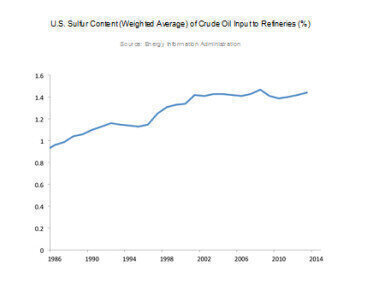-
 U.S. Sulphur Content (Weighted Average) of Crude Oil Input to Refineries (%)
U.S. Sulphur Content (Weighted Average) of Crude Oil Input to Refineries (%)
Analytical Instrumentation
Are Your H2S Analysers Ready?
Jun 13 2014
The 'sourness' of crude oil technically refers to its hydrogen sulphide (H2S) content before processing. Crude can naturally contain up to 14% sulphur content by weight, but this percentage is comprised of myriad sulphur compounds; only a small ratio is H2S. Unfortunately, even very low levels of H2S in crude can cause excessive corrosion and degrade catalysts in the refinery.
The reasons why one source of crude would be sour (e.g. Venezuelan crude) and another source would be sweet (e.g. Libyan crude) are complex. The sulphurisation of crude occurred during its initial formation, when ancient kerogen (decomposed organic matter which has polymerised) was cooked into oil by subterranean heat; the sulphur content of the living matter in that region was thus transferred to the oil reserve. Another sulphur enrichment factor is the presence of special hydrocarbon-degrading bacteria known as OHCB which reduce the hydrocarbon:sulphur ratio. The concentration of H2S in the crude rises with overall sulphur content, and thermal reactions (both geologic and during refining) can produce H2S from reactions with elemental sulphur and decomposition of unstable sulphur compounds.
Regardless of the complex reasons why, the trend is clear. The crude oil coming out of our world's reserves is growing increasingly sour (see graph).
While the trend in the US is offset by the sweet, light crude being produced from shale plays, American oil refineries have spent decades optimising their operations for the inexorable rise of sour, heavy crude, making it highly impractical for these refineries to start inputting sweet crude. This is why US oil companies are pushing for the export ban to be lifted - they can make more money selling the high-quality light crude to overseas refiners while importing cheaper sour crude.
The OMA H2S Analyzer, from Applied Analytics (USA), is a totally solid state, automated solution for real-time H2S-in-crude monitoring. This system uses a high-resolution UV-Vis spectrophotometer to measure the absorbance curve of hydrogen sulphide in the 200-300nm range; since crude oil is too opaque to transmit a light signal, Applied Analytics' unique 'headspace' sample conditioner heats the crude oil and flows in a carrier gas to produce a vapour-phase sample. In accordance with Henry's Law, the measured H2S concentration in the vapour is correlated to the concentration in the crude oil, providing an extremely accurate, fast analysis.
Digital Edition
PIN 25.2 Apr/May
April 2024
In this Edition Safety - Carbon monoxide toxic and flammable gas detection Analytical Instrumentation - Density: A fundamental parameter at critical stages within the petroleum sector...
View all digital editions
Events
May 05 2024 Seville, Spain
May 06 2024 Riyadh, Saudi Arabia
May 06 2024 Houston, Tx, USA
May 06 2024 Houston, Tx, USA
Canada Gas & LNG Exhibition & Conference
May 07 2024 Vancouver, BC, Canada

















